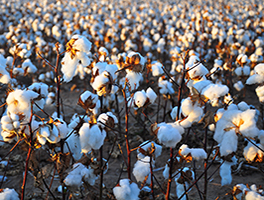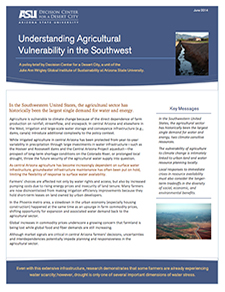June 2014
Understanding Agricultural Vulnerability in the Southwest
In June 2014, Decision Center for a Desert City released a policy brief on the complexities of agricultural water and climate vulnerability in the Southwest United States. Authored by Professors Hallie Eakin, Rimjhim Aggarwal, Abigail York, and Graduate Research Assistant Skaidra Smith-Heisters, Understanding Agricultural Vulnerability in the Southwest discusses the many variables that affect agriculture and the policy discussions that are needed to address the costs and benefits of agricultural use of water in the urban system.
The policy brief outlines how the sensitivity of agriculture to water and energy – two climate sensitive resources – makes agriculture especially vulnerable to climate change. Irrigated agriculture has largely been protected from inter-annual variation in precipitation thanks to the State of Arizona’s investment in water infrastructure, such as the Central Arizona Project. With the warming of the Southwest, snowpack, stream flow, and rainfall have become more uncertain leading to greater risk of inadequate water supply. In addition, the prolonged drought conditions in the region have thrown the future security of water supplies into question, and revealed some of the hidden vulnerabilities in the system.
The shift in irrigated agriculture towards greater reliance on surface water sources in central Arizona has helped improve groundwater levels but it has also been associated with the neglect of groundwater infrastructure in some areas. This neglect, coupled with increasing energy costs associated with pumping, have limited options for future use of groundwater as an alternative source of supply. Interestingly, this period of prolonged drought and rising energy costs has also coincided with the period of high agricultural commodity prices and the housing downturn. These events have led several farmers to rent back the land they had sold to urban developers during the housing boom. While this renting back has enabled agricultural production to increase, it has held back investments in more efficient irrigation technologies because of the insecurity of tenure on leased (as opposed to owned) land. All these linked agricultural and urban land dynamics explain the changing vulnerability of agriculture, and motivate us to study the linkages between agriculture and urban systems in planning and policy decisions.
 With the demand for food and fiber increasing worldwide, this policy brief addresses the need for policies to be aware of the effect that agriculture has on water and land use and the costs and benefits of agriculture on local economies, society, and the environment. The multiple functions that agriculture could possibly play in an urbanizing context under climate change remain largely unexplored. More research is needed to understand possible indirect benefits of agricultural land use in terms of water recharge, urban heat mitigation, open space, inter-annual water transfers, and wildlife conservation.
With the demand for food and fiber increasing worldwide, this policy brief addresses the need for policies to be aware of the effect that agriculture has on water and land use and the costs and benefits of agriculture on local economies, society, and the environment. The multiple functions that agriculture could possibly play in an urbanizing context under climate change remain largely unexplored. More research is needed to understand possible indirect benefits of agricultural land use in terms of water recharge, urban heat mitigation, open space, inter-annual water transfers, and wildlife conservation.
This brief outlines the policy recommendations to incorporate the agricultural sector into broader policy and planning for the central Arizona region as a whole. The policy discussions needed should address how water scarcity will be managed not just by farmers and water managers, but also by state and local governments, with agricultural, environmental, and municipal interests in mind.
Download the policy brief.This research is supported by the National Oceanic and Atmospheric Administration under CSI Award #NA110AR4310123 and the National Science Foundation, under award number SES-051366. Any opinions, findings, and conclusions or recommendations expressed in this material are those of the authors and do not necessarily reflect the views of the National Oceanic and Atmospheric Administration or the National Science Foundation.


